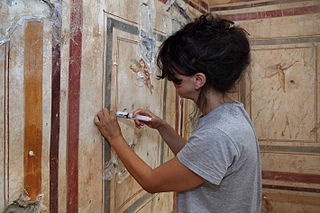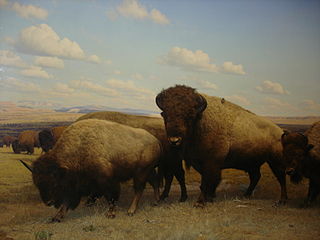Related Research Articles

Stained glass conservation refers to the protection and preservation of historic stained glass for present and future generations. It involves any and all actions devoted to the prevention, mitigation, or reversal of the processes of deterioration that affect such glassworks and subsequently inhibit individuals' ability to access and appreciate them, as part of the world's collective cultural heritage. It functions as a part of the larger practices of cultural heritage conservation (conservation-restoration) and architectural conservation.

Conservation and restoration of ceramic objects is a process dedicated to the preservation and protection of objects of historical and personal value made from ceramic. Typically, this activity of conservation-restoration is undertaken by a conservator-restorer, especially when dealing with an object of cultural heritage. Ceramics are created from a production of coatings of inorganic, nonmetallic materials using heating and cooling to create a glaze. These coatings are often permanent and sustainable for utilitarian and decorative purposes. The cleaning, handling, storage, and in general treatment of ceramics is consistent with that of glass because they are made of similar oxygen-rich components, such as silicates. In conservation ceramics are broken down into three groups: unfired clay, earthenware or terracotta, and stoneware and porcelain.

A paintings conservator is an individual responsible for protecting cultural heritage in the form of painted works of art. These individuals are most often under the employ of museums, conservation centers, or other cultural institutions. They oversee the physical care of collections, and are trained in chemistry and practical application of techniques for repairing and restoring paintings.

The conservation and restoration of outdoor artworks is the activity dedicated to the preservation and protection of artworks that are exhibited or permanently installed outside. These works may be made of wood, stone, ceramic material, plastic, bronze, copper, or any other number of materials and may or may not be painted. When applied to cultural heritage this activity is generally undertaken by a conservator-restorer.

The conservation and restoration of books, manuscripts, documents, and ephemera is an activity dedicated to extending the life of items of historical and personal value made primarily from paper, parchment, and leather. When applied to cultural heritage, conservation activities are generally undertaken by a conservator. The primary goal of conservation is to extend the lifespan of the object as well as maintaining its integrity by keeping all additions reversible. Conservation of books and paper involves techniques of bookbinding, restoration, paper chemistry, and other material technologies including preservation and archival techniques.

The conservation and restoration of Tibetan thangkas is the physical preservation of the traditional religious Tibetan painting form known as a thangka. When applied to thangkas of significant cultural heritage, this activity is generally undertaken by a conservator-restorer.

The conservation and restoration of wooden furniture is an activity dedicated to the preservation and protection of wooden furniture objects of historical and personal value. When applied to cultural heritage this activity is generally undertaken by a conservator-restorer. Furniture conservation and restoration can be divided into two general areas: structure and finish. Structure generally relates to wood and can be divided into solid, joined, and veneered wood. The finish of furniture can be painted or transparent.

The conservation and restoration of painting frames is the process through which picture frames are preserved. Frame conservation and restoration includes general cleaning of the frame, as well as in depth processes such as replacing damaged ornamentation, gilding, and toning.
The conservation and restoration of leather objects is the process of determining the causes of deterioration, followed by deciding the best course of action for preserving the leather objects for the future.

The conservation and restoration of frescoes is the process of caring for and maintaining frescos, and includes documentation, examination, research, and treatment to insure their long-term viability, when desired.
The conservation and restoration of lacquerware prevents and mitigates deterioration or damage to objects made with lacquer. The two main types of lacquer are Asian, made with sap from the Urushi tree, and European, made with a variety of shellac and natural resins. Lacquer can be damaged by age, light, water, temperature, or damaged substrate.

Textile stabilization is a conservation method for fiber and yarn-based cloth intended to mitigate damage, prevent degradation and preserve structural integrity. Stabilization is part of a broad set of techniques in the field of conservation and restoration of textiles typically undertaken by a specialist or textile conservator. Appropriate treatment is determined through risk assessment and close examination of a textile's characteristics and the nature of the damage. Organic and synthetic fibers become weak due to age, handling, and environmental exposure and display physical deterioration such as fraying, planar distortion, loss, and change in surface character. Treatment involves reinforcing tensile strength and reintegration of parts for aesthetic, functional, and historic preservation. Methods can include stitching, darning, reweaving, and the attachment of supports through overlays and underlays. Hand-sewing follows the mantra of “gently does it” using fine needles, supple yarns, and a light touch. Heavily damaged and fragile fabrics often require stabilization through adhesive consolidation, though this is less common. It is essential that conservators consider physical and chemical compatibility along with future treatability in choosing a stabilization technique.

The conservation and restoration of paintings is carried out by professional painting conservators. Paintings cover a wide range of various mediums, materials, and their supports. Painting types include fine art to decorative and functional objects spanning from acrylics, frescoes, and oil paint on various surfaces, egg tempera on panels and canvas, lacquer painting, water color and more. Knowing the materials of any given painting and its support allows for the proper restoration and conservation practices. All components of a painting will react to its environment differently, and impact the artwork as a whole. These material components along with collections care will determine the longevity of a painting. The first steps to conservation and restoration is preventive conservation followed by active restoration with the artist's intent in mind.

The conservation and restoration of woodblock prints, is the process of caring for and repairing images made from a specific printing process involving using wooden reliefs to stamp or imprint an image onto paper. The process of creating woodblock prints as Asian examples are known, or woodcuts as Western examples are called, has been known for many centuries, and many older prints have experienced aging and deterioration of the paper and colorants used.
The conservation and restoration of ancient Greek pottery is a sub-section of the broader topic of conservation and restoration of ceramic objects. Ancient Greek pottery is one of the most commonly found types of artifacts from the ancient Greek world. The information learned from vase paintings forms the foundation of modern knowledge of ancient Greek art and culture. Most ancient Greek pottery is terracotta, a type of earthenware ceramic, dating from the 11th century BCE through the 1st century CE. The objects are usually excavated from archaeological sites in broken pieces, or shards, and then reassembled. Some have been discovered intact in tombs. Professional conservator-restorers, often in collaboration with curators and conservation scientists, undertake the conservation-restoration of ancient Greek pottery.

The conservation of taxidermy is the ongoing maintenance and preservation of zoological specimens that have been mounted or stuffed for display and study. Taxidermy specimens contain a variety of organic materials, such as fur, bone, feathers, skin, and wood, as well as inorganic materials, such as burlap, glass, and foam. Due to their composite nature, taxidermy specimens require special care and conservation treatments for the different materials.
The conservation-restoration of panel paintings involves preventive and treatment measures taken by paintings conservators to slow deterioration, preserve, and repair damage. Panel paintings consist of a wood support, a ground, and an image layer. They are typically constructed of two or more panels joined together by crossbeam braces which can separate due to age and material instability caused by fluctuations in relative humidity and temperature. These factors compromise structural integrity and can lead to warping and paint flaking. Because wood is particularly susceptible to pest damage, an IPM plan and regulation of the conditions in storage and display are essential. Past treatments that have fallen out of favor because they can cause permanent damage include transfer of the painting onto a new support, planing, and heavy cradling. Today's conservators often have to remediate damage from previous restoration efforts. Modern conservation-restoration techniques favor minimal intervention that accommodates wood's natural tendency to react to environmental changes. Treatments may include applying flexible battens to minimize deformation or simply leaving distortions alone, instead focusing on preventive care to preserve the artwork in its original state.
The conservation and restoration of Pompeian frescoes describes the activities, methods, and techniques that have historically been and are currently being used to care for the preserved remains of the frescoes from the archeological site of Pompeii, Italy. The ancient city of Pompeii is famously known for its demise in A.D. 79 after the fatal eruption of Mount Vesuvius wiped out the population and buried the city beneath layers of compact lava material. In 1738, King Charles III or Charles of Bourbon, began explorations in Portici, Resina, Castellammare di Stabia, a Civita, where it was believed that the ancient cities of Pompeii, Stabiae, and Herculaneum were buried beneath. The first phase of the excavations at Pompeii started in 1748, which led to the first conservation and restoration efforts of the frescoes since their burial, and in 1764, open-air excavations began at Pompeii. Pompeii has a long history of excavation and restoration that began without a strong foundation or strategy. After centuries of cronyism, recurring financial shortages, and on-again-off-again restoration, the city's frescoes and structures were left in poor condition. In 1997, Pompeii was added to the UNESCO List of World Heritage Sites.

The conservation and restoration of photographic plates is the practice of caring for and maintaining photographic plates to preserve their materials and content. The practice includes the measures that can be taken by conservators, curators, collection managers, and other professionals to conserve the material unique to photographic plate processes. This practice includes understanding the composition and agents of deterioration of photographic plates, as well as the preventive, and interventive conservational measures that can be taken to increase a photographic image's longevity.

The conservation and restoration of quilts refers to the processes involved in maintaining the integrity of quilts and/or restoring them to an acceptable standard so that they may be preserved for future generations. Quilts have been produced for centuries, as utilitarian blankets, decorations, family heirlooms, and now treasured museum collections objects. Quilts are three-layered textile pieces with a decorated top, a back, and a filler in the middle. The composite nature of these objects creates an interesting challenge for their conservation, as the separate layers can be made of different textile materials, multiple colors, and therefore, varying degrees of wear, tear, and damage.
References
- 1 2 3 4 5 6 7 8 YOUNG, C., & ACKROYD, P. (2001). The Mechanical Behaviour and Environmental Response of Paintings to Three Types of Lining Treatment. National Gallery Technical Bulletin, 22, 85-104. Retrieved May 8, 2021, from http://www.jstor.org/stable/42616153
- 1 2 3 4 5 6 7 8 9 10 11 12 Hackney, Stephen. "Tate Papers – Paintings on Canvas: Lining and Alternatives". Tate Gallery.
- 1 2 3 4 5 6 7 8 9 10 11 12 Ackroyd, Paul (2002). "The structural conservation of canvas paintings: changes in attitude and practice since the early 1970s". Studies in Conservation. 47 (1): 3-14. doi:10.1179/sic.2002.47.Supplement-1.3. S2CID 192035149 . Retrieved 13 May 2021.
- ↑ "Agents of deterioration". 14 September 2017.
- 1 2 3 4 The Museum Handbook: Appendix L: Curatorial Care of Easel Paintings (PDF). National Park Service. pp. L:1–L:12.
- 1 2 3 4 5 Fielding, Theodore Henry (1847). Knowledge and Restoration of Old Paintings. London: R. Ackermann & Co. pp. 59 -61.
- 1 2 3 4 5 6 Ackroyd, Paul (2002). "The Structural Conservation of Canvas Paintings: Changes in Attitude and Practice since the Early 1970's". Reviews in Conservation (3): 3–14.
- 1 2 Coddington, J.; Young, C. (May 2018). "Structure and Lining: A Review. AIC News, 43(3), pp. 1, 6-8" (PDF). www.culturalheritage.org.
- 1 2 Berger, Gustav (1975). "Heat-Seal Lining of a Torn Painting with BEVA 371". Studies in Conservation. 20 (3): 126–151. doi:10.1179/sic.1975.20.3.012.
- 1 2 Bomford, David; Staniforth, Sarah (1981). "Wax-Resin Lining and Colour Change: An Evaluation". National Gallery Technical Bulletin. 5.
- 1 2 3 4 Stoner, J. (1994). The Impact of Research on the Lining and Cleaning of Easel Paintings. Journal of the American Institute for Conservation, 33(2), 131-140. doi:10.2307/3179422
- 1 2 3 4 Attia Mohie, Moustafa; Mahmoud Ali, Naglaa; Abd Alkareem Bani Isa, Ahmad (2019). "A New Method of Lining Oil Paintings using Polyurethane" (PDF). Mediterranean Archaeology and Archaeometry. 19 (2): 9–21.
- 1 2 Alba, Ana (April 6, 2016). "Treatment of Benjamin Franklin: Removal of the Lining".